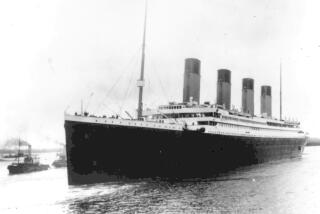Titanic: Life, death aboard the ship that sank 100 years ago today
The legend of the Titanic disaster has been plumbed, plundered and presented in 3-D, but the ship that famously sank 100 years ago today in the North Atlantic has shown remarkable tenacity in its grip on popular imagination.
Some argue about what keeps the tale of the Titanic sailing. Is it the money? The 1997 movie, James Cameron’s film, depicting the interrupted journey of the British passenger liner from Southampton, England, to New York, certainly had something to do with it. “Titanic” burned dramatic images into the collective conscience.
But it’s the real-life stories that seem indelible -- hundreds of tales of heroes, survivors, anguish and lost love.
It’s no wonder the tragedy remains so vivid a century later. Years from now, the stories of April 14, 1912, will likely still be told.
Life or death? For them, a clear choice
The Titanic was an RMS -- a Royal Mail Ship. The ship’s cargo of mail was considered precious. But was it worth dying for? On April 15, five men had to decide.
The Smithsonian’s National Postal Museum tells the story of the three Americans and two Britons who served as postal workers aboard the Titanic. Americans Oscar Scott Woody, John Starr March and William Logan Gwinn and British colleagues James Bertram Williamson and John Richard Jago Smith were experienced and greatly respected -- the cream of the Sea Post Service crop. Working on this maiden voyage of the Titanic was a coup, a high point in an era that itself was the high point of the service.
More than 3,000 mailbags filled with transatlantic mail were aboard the Titanic. While the ship was underway the clerks worked at sorting the mail for New York and other U.S. destinations.
The room on the Titanic where the five worked was a cut above the usual shipboard workspace. In most ships, such post offices where the men toiled over the course of a voyage were often cramped and stuffy. By comparison, theirs was posh.
But the men didn’t like their third-class accommodations with “low class Continentals,” the Smithsonian site says. Postal officials agreed to move them away from the noise and “instrumental music” of those of lesser means, and they were given a private area in which to dine.
On April 14, 1912, Woody and his colleagues were at the stern of the Titanic celebrating his 44th birthday, which was the following day, according to a fellow Freemason. But the party was interrupted when the ship hit an iceberg.
That night, as the Titanic sank, all five men struggled to save the mail, focusing on 200 bags that they attempted to drag from G Deck to C Deck.
Steward Albert Theissinger was helping them. He gave up to save his own life, but they did not. The last time he saw the men they were up to their waists in frigid water. Theissenger said: “I urged them to leave their work. They shook their heads and continued.”
All five perished.
It took a century, but Titanic Album surfaces
Francis Patrick Mary Browne was one of the lucky few to disembark from the Titanic. The 32-year-old Jesuit priest in training was one of eight passengers who got off the ship at Cobh, Ireland, on April 11. And with him he carted away a treasure: photographs he’d taken of the maiden voyage of a ship that four days later would be at the bottom of the sea.
The pictures taken by the man who went on to become Father Browne appeared in newspapers and journals following the Titanic disaster, as well as “virtually every book published about Titanic ever since,” according to the Irish Times.
They are the only photos of the voyage of the ship that have emerged in 100 years. Browne in 1920 assembled 159 of his Titanic photos into a personal album, which came to be known as the Titanic Album.
Browne put the album together, adding his own handwritten captions, Edwin Davison told The Times in an interview Friday.
Davison and his father, owners of Dublin-based commercial photography company Davison & Associates, set out on a mission nearly 25 years ago to duplicate Father Browne’s pictures, including those from the Titanic as well as thousands of others the prolific photographer priest snapped over the course of his lifetime.
This Titanic Album “is not for public display,” Davison said. It has been held in a bank vault in Dublin, “one of the absolute prize possessions” of the Irish Jesuit order. Davison obtained the order’s OK to bring the album to the U.S. for the first time, coinciding with the centennial of the ship’s sinking. It’s on display at the Titanic Museum in Pigeon Forge, Tenn., now through April 22.
Browne’s Titanic photos -- which were on crumbling and flammable cellulose nitrate film -- include the final known image of Capt. Edward Smith, the last time the ship’s anchor was hauled in and the only picture of the radio room, called the Marconi Room.
Browne even recorded the near-miss between the Titanic and a New York steamer off Southampton, England. When the much smaller ship was sucked into the wake of the Titanic its moorings snapped, and the vessels missed colliding by mere feet.
In his caption, Browne says the sound of the snapping was “like pistol shots,” Davison said.
Browne’s Titanic images have been seen individually, but Davison said the album’s 63 pages of captions, press clippings and memorabilia from the voyage have “a special kind of presence.” Its pictures are sharply poignant, capturing as they do a sense of life aboard the doomed ship.
Davison says possibly the most iconic image was captioned “the children’s playground.” It shows young passenger Doug Spedden at play, spinning a top on the deck of the ship.
The quiet survivor
On the night the ship sank, 2nd Officer Charles Herbert Lightoller dived head-first from an upper deck -- and survived.
One would think that would be the most exciting point in a person’s life. But Lightoller “had a full life,” said his grandson Capt. Tim Lightoller in an interview Thursday with The Times.
Charles Lightoller -- the most senior officer to survive the disaster -- survived several other shipwrecks, his descendant said, and was, at various times, a furrier, a boat builder, a cattle wrangler and even a hobo. In World War II, he was involved in the Miracle of Dunkirk; in his own 52-foot yacht, he helped rescue 127 soldiers in the Dunkirk evacuation of June 1940, when British, French and Belgian troops were cut off by the German army.
Tim Lightoller, a retired Royal Navy captain who lives in Scotland, was in the United States recently to take part in events commemorating the 100th anniversary of the Titanic’s fateful maiden voyage. His grandfather “did not like talking about the Titanic,” the younger Lightoller said. But Charles Lightoller did write a book in 1937, an autobiography of his life up to that point, and the dedication read: “To my persistent wife, who made me do it.” That summed it up well, Tim Lightoller said with a laugh.
“He didn’t like talking about things, he just liked getting on and doing the job.” But with his book and another about him, “Titanic Voyager,” by Patrick Stenson, Charles Lightoller’s experiences aboard the ship came to light. As he wrote in his autobiography: “Captain Edward John Smith, with every other senior officer (apart from myself) went down, and was lost with the ship.”
How was it Charles Lightoller survived? He didn’t do it by boarding one of the lifeboats being lowered into the ocean, according to his grandson.
On the night of the disaster, Lightoller had finished his watch and completed his rounds of the ship. He’d gone to his cabin, “gotten into his bunk and was going to sleep” when he felt “a bit of a lurch,” Tim Lightoller said. “So he got up and wandered onto the deck, met with one of the junior officers, and they couldn’t see anything .… They went back to their cabins and about 10 minutes later one of the officers of the watch said, ‘We hit an iceberg.’ ”
Lightoller threw some clothes on and “began to launch the portside lifeboats. The instructions were agreed that it was women and children first” because, as generations since have learned, there weren’t enough lifeboats to go around.
“The overriding factor for him … was the passengers,” Tim Lightoller said. “That was his responsibility.”
He was told by a chief officer to board one of the last lifeboats and he refused to do so. When he “felt the water lapping on his feet,” he dived into the ocean. He soon became trapped against a wire grating on one of the huge funnels that rose up from the boilers 150 feet below. The rush of water pouring down the shaft pinned him to the grating. He was drowning when a massive burst of air rose from the shaft and flung him away.
In his book, Charles Lightoller tells how he was again “sucked down by an inrush” of water. “Just how I got clear of that, I don’t know, as I was rather losing interest in things.” But he eventually resurfaced near a collapsible lifeboat that he’d launched earlier and hung on to a piece of rope dangling from the boat.
Another funnel toppled, between the ship and the lifeboat to which Lightoller clung, narrowing missing him but “washing him clear of the ship,” Tim Lightoller said. The officer and about 30 other struggling people then boarded the collapsible vessel, transferring eventually to Lifeboat No. 12.
The next morning, they boarded the Carpathian, the steamship that rescued Titanic survivors. “He was the very last person aboard the Carpathian.”
RELATED
PHOTOS, video, stories: Titanic 100 years later
There may be new protections for the ship’s ‘hallowed ground’
Who was -- and wasn’t -- on board the Titanic? Now you can find out
More to Read
Sign up for Essential California
The most important California stories and recommendations in your inbox every morning.
You may occasionally receive promotional content from the Los Angeles Times.











